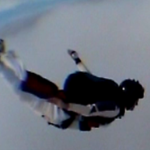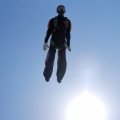Recommended Posts
Quote....looking at my hands, I looked like I could claw the slate off a caulkboard. I relaxed my arms, shoulders, and hands. I noticed my hands lifted up an inch or two, which I would think is good.
This is why I asked. All too often students are told "relax!" with no explanation on what that really means.
And it means different things to different people.
What we, as instructors could do better across the board is explain exactly what we are looking for when we say "relax!".
Here's what I tell my students:
-Relax means to let you hands go limp. Hence, the limp-wristed hand signal.
-Take a deep breath, let your hands go limp and smile. Let the air blow by you smoothly.
-If you get a "relax" signal, it's because you are tense and stiff. You will feel the air bouncing you around.
(I demonstrate what you described as the "claw the slate off a caulkboard.")
-Let your hands go limp, quit fighting the air, and you will feel the air pushing your arms back and you'll feel the freefall smooth out considerably which is what we are after.
(I demonstrate the limp wrists with a smile and an exaggerated calm expression on my face.)
If some other instructor has a better presentation, it would be great if you would share it here for the benefit of all of us.
"claw the slate off a caulkboard"....
"I noticed my hands lifted up an inch or two, which I would think is good"
Yes, it is. It's one of the effects of actually "relaxing" in the air.
I was a tense freefall student. Back in the day, I was a plank. What got me over the hump was my first solo after AFF where I did nothing but float and enjoy the view that God gave us. It was about the middle of the freefall when I realized how smooth everything felt.
I think we're all Bozos on this bus.
Falcon5232, SCS8170, SCSA353, POPS9398, DS239
pchapman 281
Quote
This is why I asked. All too often students are told "relax!" with no explanation on what that really means.
And it means different things to different people.
It does indeed take some explanation. For example, that one can relax too much too. Lower legs bouncing in and out randomly in the air stream, strange body positions on a tumbled exit, etc. One has to apply some muscle power to attain and hold the desired body position (arch and all that), yet still not be rigidly stiff.
So shouting at a student like a drill sergeant to RELAX!! isn't correct?
QuoteSo shouting at a student like a drill sergeant to RELAX!! isn't correct?
PFC Schmidt, after the initial culture shock wears off, would probably think it is.
I think we're all Bozos on this bus.
Falcon5232, SCS8170, SCSA353, POPS9398, DS239
Amyr 0
rss_v 0
If anyone is still reading this thread - how long do you think I need in the tunnel? To give you more info, I have passed level 4 (just about) previously. The tunnel is cheaper than jumping but still "expensive" so though I'm sure every extra minute helps, basically what I want is just enough to get me through my AFF with no more rejumps. Are we talking about 10 minutes, 20, 30, more?
It's cheaper per minute the more I book, of course, so if I go for less and end up needing more, I pay more than I would have if I bought it all at once. You know how it works.
What do you reckon?
Thanks
1) There's no good answer to that question - it will depend on you, your coach, and what your problems really turn out to be.
But.
2) There is no such thing as "too much" tunnel. It's certainly expensive, but the minutes you spend in there will benefit your flying no matter how many they are - if your standard increases to the point where the rest of your AFF is a breeze, it's certainly not a waste. I know you want to be as efficient as possible and you're really focused on finishing your AFF, but your skydiving journey is just beginning after that.
Even if you did ten hours coached, you'd still just be scratching the surface of what the tunnel can teach you ![]()
"I'll tell you how all skydivers are judged, . They are judged by the laws of physics." - kkeenan
"You jump out, pull the string and either live or die. What's there to be good at?






Share this post
Link to post
Share on other sites